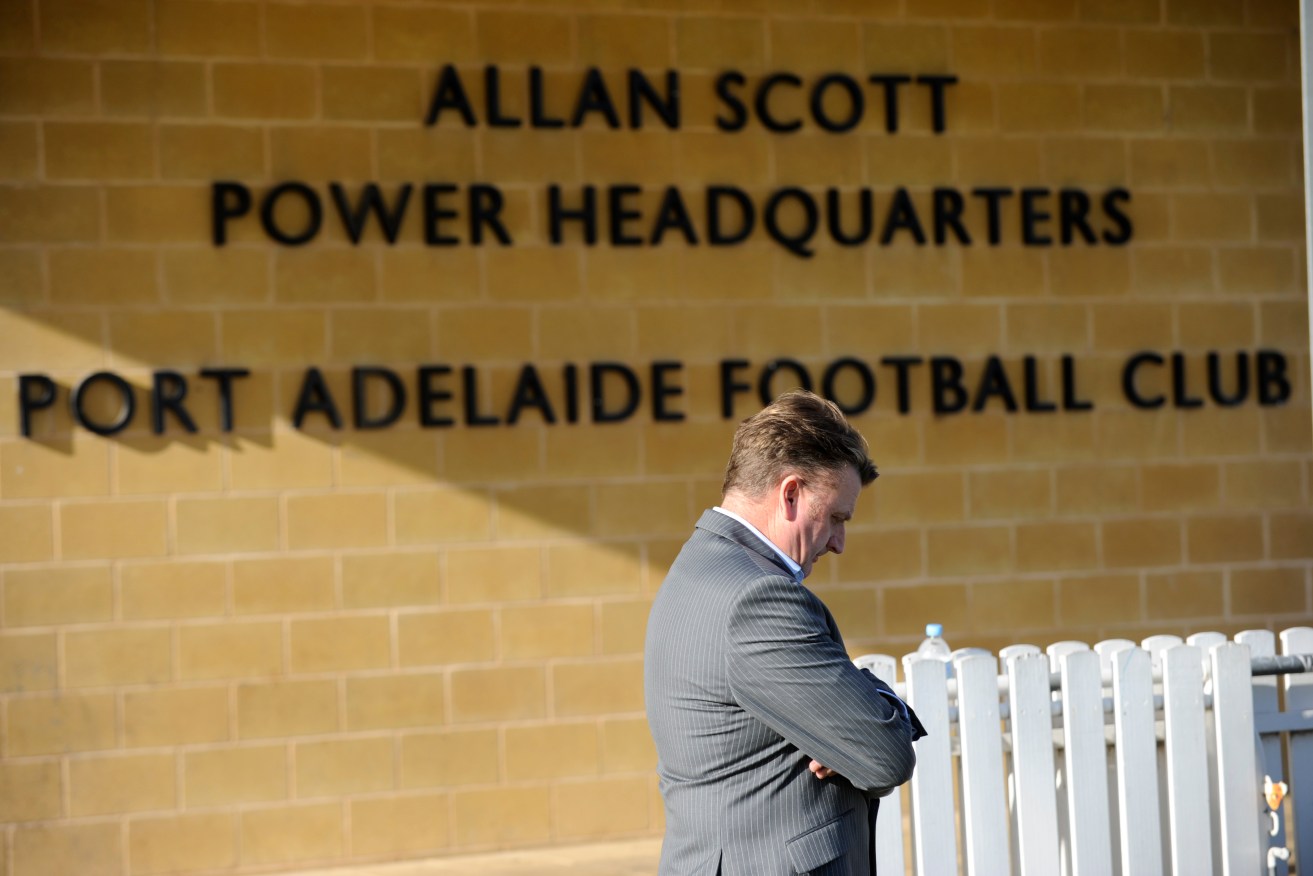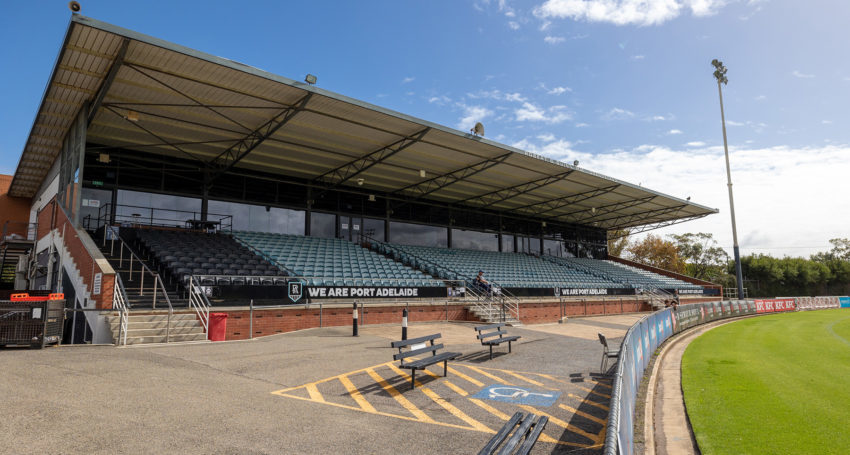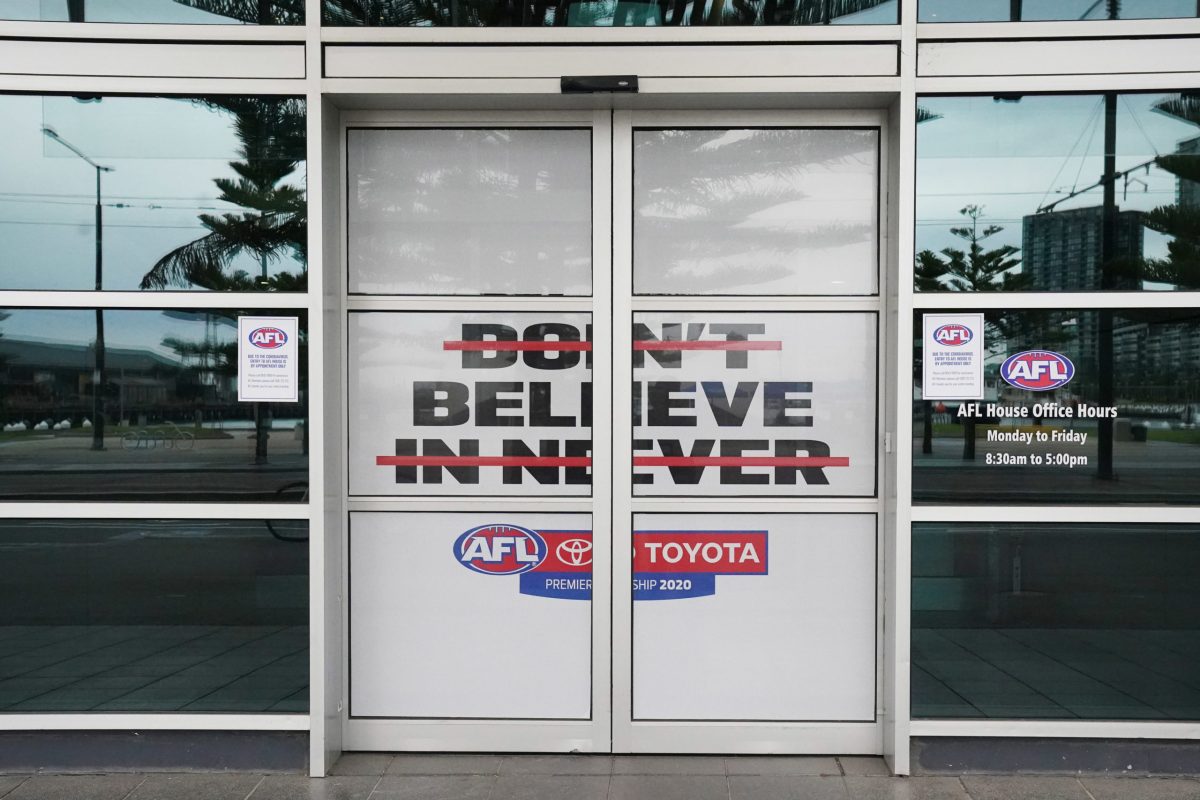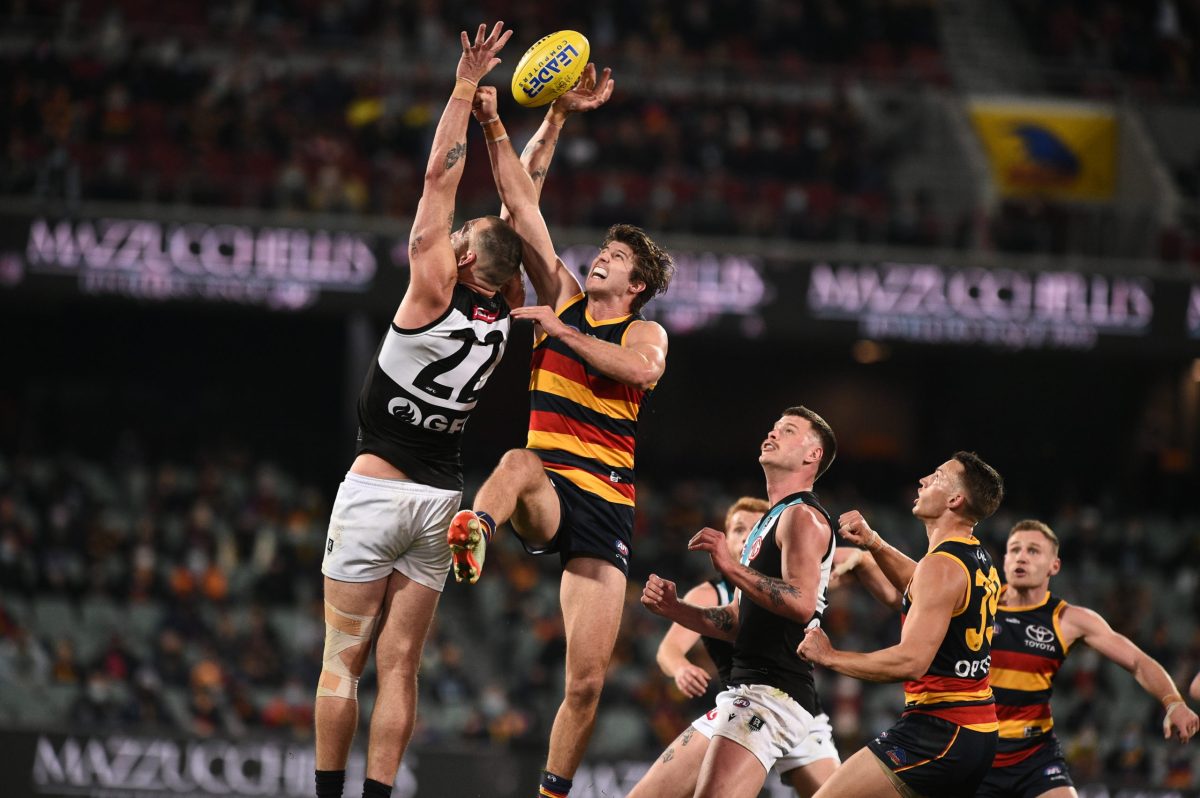The scar tissue of Port Adelaide Football Club’s darkest hours
Port Adelaide was on its knees a decade ago – at serious risk of having its AFL licence revoked – and the scars of those caught up in the crisis are still raw. Michelangelo Rucci revisits one of the ugliest chapters in SA football.

Port Adelaide president Brett Duncanson in 2012. Photo: AAP/David Mariuz
Brett Duncanson’s first words as the Port Adelaide Football Club president in 2009 were of “privilege and honour”. His last were lost in a tearful and awkward press conference in 2012.
Duncanson inherited an AFL club that in the previous five years had played in two grand finals, but by 2011 was lucky to avoid its first wooden spoon in 111 years. The collapse was extraordinary, particularly from a club that had been so powerful on a smaller stage in the SANFL.
A dream became a nightmare rather than a privilege or honour: personally for Duncanson and his fellow volunteers on the Port Adelaide board, and for a financially-drained football club that could have easily lost its hard-earned seat at the AFL table.
A decade after Port Adelaide’s so-called dark chapter came to an end – with the AFL taking control to parachute into Alberton a new president (David Koch), new chief executive (Keith Thomas) and new coach (Ken Hinkley) – Duncanson can (unlike in his final press conference) speak of one of the most-bitter moments in SA football without losing his emotions.
But picking at the scars, even a decade later, does highlight the human cost of the second war between the SANFL, AFL and Port Adelaide (after the first of 1990 when the AFL used Port Adelaide to break the SANFL’s long-standing reluctance to join an expanding VFL competition).
“It was not a great time in my life,” says Duncanson speaking to InDaily in his first media interview since vacating the presidency a decade ago.
“It was just horrible. And I will take to my grave how we were treated. No-one deserves to be treated like that. It was just wrong.”
Duncanson, 59, has kept some of the brutal text messages fired at him by leading figures of SA football during 2011 and 2012, when repeat losses and poor crowds at Football Park were loading the Port Adelaide Football Club with choking debt and financially crippling the owner of its AFL licence and home venue at West Lakes – the SANFL.
“We all,” adds Duncanson, speaking of the board that was sacked in Melbourne on the morning of the 2012 AFL grand final, “went out with a bitter taste in our mouths on so many levels. There are people who have been left with deep scars.”
I will take to my grave how we were treated. No-one deserves to be treated like that. It was just wrong
After AFL chief executive Andrew Demetriou confirmed Koch’s appointment on the morning of the league grand final – stopping Port Adelaide’s inaugural AFL chief executive Brian Cunningham from returning to the club as president – Duncanson’s lame-duck board was called to a surprise meeting in Melbourne. Deputy chairman Kevin Osborn told former player Bruce Abernethy, former SANFL club president David Basheer and successful businessmen Nick House and Mick O’Connor they had been boned.
This followed directors Jane Jeffreys, the first woman elected to the Port Adelaide board, and John Hood being nudged by the SANFL to make room for its own “observers” on the board. Premiership player Darryl Wakelin had jumped before being pushed.
The shock from the sackings demanded by the AFL was significant, particularly to those who thought the AFL’s hands-on approach was the light at the end of the long, dark tunnel at Alberton. One director did not speak freely in public gatherings for days. One returned to Adelaide to dump all his football memorabilia. Another would ask – even at dinner parties – for television sets to be turned off if the screen was showing a football game, in particular a Port Adelaide match.
“No-one saw that coming,” Duncanson said. “The SANFL would say the AFL was out to get us. I don’t have stupid stamped on my forehead. I know what the AFL’s play was all about, and who and what the AFL were after.
“The timing of that meeting was nothing short of cruel,” adds Duncanson who was frozen out of board meetings immediately after his resignation in early August 2012 at a joint press conference that was to have been dominated with questions to sacked coach Matthew Primus.
“Why not a week before the grand final? Why not the Monday after the grand final? Why that morning? We were not treated with respect by the governing bodies of the game. No-one in football – or anywhere – should be treated like that.
I sent several emails (to the SANFL and AFL) asking, ‘What did we do wrong?’ They have never been answered. We didn’t kill anyone.”
I don’t have stupid stamped on my forehead. I know what the AFL’s play was all about, and who and what the AFL were after.
Generally, the answer is Port Adelaide, under Duncanson’s leadership, collapsed on and off the field, sent the SANFL into record debt ($45 million) and engineered the end of the SANFL’s major asset, Football Park. To many in SA football, it was the sequel to 1990. The Port Adelaide directors were branded as incompetent, and their club was the anchor sinking SA football into a financial crisis.
“I hope,” says Duncanson, “people are not going to rewrite history.”
So where did it go wrong?
“Remove the emotion,” answers Duncanson, “and you will find the business model for the Port Adelaide Football Club was unworkable.
“(Inaugural president) Greg Boulton and Brian Cunningham did a great job getting us to the AFL in 1997 and winning the premiership (in 2004).
“But by 2009, the model the club had at the start was busted. The cost of running an AFL club compared with the revenue we were making meant we did not have a sustainable model. We had to make a quantum change.”
Duncanson and his board settled on three key platforms.
“Bring the club (that was split on AFL and SANFL lines by order of the SA Football Commission) back together,” said Duncanson who played a tireless role in the “One Club” strategy fronted by Port Adelaide heroes George Fiacchi and premiership captain Tim Ginever.
“Get a new stadium deal at Football Park – a negotiation that confirmed we needed a new stadium. If were not getting 22,000 to Football Park, we were writing a cheque (to the SANFL). We were at a stadium our people did not want to go, even when we were winning.
“Remove the duplication of governance with the AFL and SANFL. We weren’t beating up the SANFL. Too often, AFL strategy is not aligned with SANFL needs. Constantly, Port Adelaide became the meat in the sandwich. Who were we answerable to? The AFL or the SANFL? By law, we were compelled to act in the best interests of the club. Hand on heart, every decision we made was right for Port Adelaide.”

Port Adelaide Football Club’s Alberton Oval home. Photo: Tony Lewis/InDaily
A decade on, Duncanson knows that Port Adelaide – as in 1990 – was the AFL’s Trojan horse to end decades of unrest between the AFL and SANFL.
“The AFL took us to the cliff,” says Duncanson. “When the AFL is handing Collingwood more funding than Port Adelaide, you have to ask why.
The answer is they wanted the AFL licences (at Adelaide and Port Adelaide) out of the SANFL’s hands (a deal struck in 2014).
“The AFL left the SANFL to fund us, and the SANFL funded us to ‘just enough’. The club should always be grateful to the SANFL.
“We were in the middle of a power play and we did not see it at the time. We trusted people for what they told us. Looking back, that clearly was the AFL’s play – to get back the licences in South Australia. It was a very smart play by the AFL.”
Duncanson recalls how then AFL Commission chairman Mike Fitzpatrick would arrive in Adelaide saying: “I feel I am in a Middle East war zone.”
Duncanson still has no insight to the AFL’s Plan B with the Port Adelaide Football Club – that included rebranding the club – had the SANFL sent the licence back to AFL House to avoid incurring more debt.

AFL House in Melbourne. Photo: AAP/Michael Dodge
He is very sure however on the AFL’s initial plan to dismantle the clause written in 1990, with the Adelaide Football Club licence demanding all AFL games in South Australia be played at Football Park. It was another divide-and-conquer move, a repeat of 1990.
“Remember how that $100 million commitment from the State government to redevelop Football Park suddenly came off the table?” says Duncanson.
This followed Demetriou calling then SA Treasurer and deputy Premier Kevin Foley to say: “You are not putting lipstick on that pig!”
“Everyone will deny it,” adds Duncanson, “but what had not come out of all the events from 2010-2012 is the AFL wanted us (Port Adelaide) to play at Adelaide Oval, an undeveloped Adelaide Oval. The Crows would have been at Football Park.
“Port Adelaide in a boutique stadium of 35,000 would have suited our business model. But it would not have been in the best interests of the state, the game here or even the Crows. Having the two AFL teams at different venues – with Port Adelaide having an advantage in the city centre – would have created an enormous blow up in this state. That was my message to the state government.”

Port Adelaide and the Crows play Showdown 50 at Adelaide Oval in August 2021. Photo supplied
Duncanson describes Port Adelaide as the “driving force” in the $535 million deal that took elite football back to Adelaide Oval to end a 40-year impasse between the SA Cricket Association and the SANFL.
“People will rewrite history,” he said. “And people will gloss over how the SACA was saved from falling over with $90 million of debt.”
A decade on, Duncanson feels his much-lampooned board is harshly judged.
“I only answer to the mirror, not what people think of me,” says Duncanson. “I do know how Bruce Weber (Port Adelaide’s president during the 1990 storm) felt. I would get people doing double-takes when they saw me in the supermarket. Now, they thank me. I only wish the other directors, who did not have the profile that comes with being an AFL club president, could get the same thanks. It costs nothing to say thank you.
“Surely we are judged by where the club is today,” Duncanson adds. “David Koch has done a fantastic job. The club has taken every advantage of the opportunity (created at Adelaide Oval and from the painful episodes from 2010-2012). They refreshed the Port Adelaide brand. They delivered a great game-day experience at Adelaide Oval. I am proud that we set up that opportunity.”
But there are – along with the scars on Duncanson and his fellow directors – the lingering memories of a team that won just eight of 44 games in 2011-12 and played to record low crowds of 13,683 (against West Coast) and 13,953 (against Brisbane) in 2012, a time of tarps at Football Park.
“We were trying to survive off the field, so we did take the eye off (football), and the results reflect that,” Duncanson said. “We were volunteers, putting in 30-40 hours a week. There were successful businessmen on that board being thwarted by outsiders saying, ‘We know better’ on how to run a football club. The SANFL was telling us, ‘You don’t know what you are doing’. They brought in their own independent assessors.”
“After 12 months, the independent assessment was this board could not do any more – the business model is broken. And then it was about attacking the individuals.”
When the SANFL learned of Port Adelaide’s intent to get to Adelaide Oval, the response was clear, as was the backlash towards Duncanson.
“We were told hell would freeze over before we played at Adelaide Oval,” Duncanson said.
Once seen as a candidate for the SA Football Commission, Duncanson became the SANFL’s No. 1 enemy.
“They wanted youth on the commission and told me I was part of the future of SA football,” said Duncanson, who at 30 became the youngest director to ever serve on the Port Adelaide board.
“While I was making a presentation to the wine industry at the Wayville Showgrounds, the SANFL sent (commissioner) David Shipway with nomination forms for a commission vacancy at 4.45pm with a 5pm deadline.
“Years later, they were calling me everything under the sun. I went full circle.”
Port Adelaide did get to Adelaide Oval for the closing home-and-away game of AFL Season 2011 for a match against Melbourne, with more than the risk of claiming the wooden spoon worrying Duncanson.
“I deliberately walked the line outside the oval that day knowing if we had 10,000 at the game we would get smacked,” Duncanson said. On that sunny Sunday afternoon in late August, there was a full house of 29,340.
“The overwhelming reaction from the fans was, ‘Make sure we come here’. They told me Adelaide Oval felt like home, something Football Park was not.
“Halfway through the second quarter, Andrew Demetriou was saying to me, ‘You guys were right (about Adelaide Oval rather than a new city venue near the old Coca-Cola bottling plant at Port Road). Adelaide Oval is going to be sensational’.
“I go to Adelaide Oval today proud of what we set up. It formed the nucleus of our resurgence as a football club and has done pretty well for the Crows, SANFL and the city as well. Even the Adelaide Football Club would acknowledge Adelaide Oval has far exceeded expectations.
“I am overwhelming proud of what we did to make Adelaide Oval work. I only wish the other directors were recognised more.”
Thomas did ensure Duncanson and every member of his board were at the first AFL game – the Showdown of round 2, 2014 – when Adelaide Oval re-opened with new pavilions catering for 53,500 fans.
“I was emotional,” Duncanson said. “I know how so many were hurt to get to that moment. Those people did not deserve to be treated like that.”
Today, Duncanson goes to Port Adelaide matches at Adelaide Oval as a fan. He avoids the formal functions.
“Keith Thomas (who left Port Adelaide at the end of 2020) asked me, ‘When is it the right time to go back?’ My answer is, when you feel you want to go back,” Duncanson said. “I felt comfortable to go back straight away. Others (from his board) did not.”
A decade on, Duncanson – regardless of the scars left by the darkest chapter in Port Adelaide’s 152-year history – maintains “it was definitely worth it”.
“It was a privilege, and I am driven to make a difference,” said Duncanson, who today leads an award-winning business and chairs the Sammy D Foundation that helps youth in avoiding alcohol-induced violence.
“I never forget my father, who would lift me as a young boy to see over the pickets at Alberton Oval, saying to me that I needed to give it away, that it was not worth it. But it was.
“Twelve months after I resigned, my wife asked why would anyone go through that. Why? Because we made significant change for Port Adelaide.”
There is that final act – the tearful press conference.
“That is one of my biggest regrets,” Duncanson said. “I was exhausted. It had been relentless. I walked into that press conference being told a Port Adelaide (SANFL) player had lost his father in an industrial accident. That triggered a couple of things … I should have announced I had resigned, said my bit and walked away from that press conference leaving it to Matty (Primus).
“Ten years on, I am enormously proud of what the whole board did, and (chief executive) Mark Haysman who took a lot of hits. And I keep asking the same question: tell me of any decision my board made that was not in the best interests of the State?”




